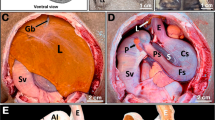Summary and Conclusions
From the foregoing pages it is clear that the present form shows a number of interesting features in which it markedly differs from the other species of the genus. These characters seem to me of sufficient value for the creation of a new species for its reception and for which I propose the namePraegeria gopalai. The important characters of this species can now be summarised as follows:
Minute slender worm, 4 to 10 mm. long, with 25 to 50 setigerous segments; ventral cirrus of the buccal parapodium globular; ventral cirrus of the first setigerous foot slightly elongated; anal segment with two conspicuous groups of caudal glands; only a single pair of sperm-sacs, genital funnels and copulatory organs in the male; secondarily median testis enclosed in a membrane and often extending into two segments; tapering entire copulatory organ provided with a large spinous papilla sperm-sacs having double saccular expansions; in the female, one or two ovarian groups covered over by a membrane and each group extending into 6 to 15 consecutive segments; receptacula seminis and genital funnels corresponding to the number of ovarian groups; parapodia of the segment carrying the receptacula seminis completely atrophied and carrying only two acicula; sperms from the receptacula seminis nail shaped having developed a conspicuous terminal hood.
Locality: —Sandy Beach, Madras.
Holotype: —In the Indian Museum, Calcutta.
Similar content being viewed by others
Abbreviations
- a. :
-
Acrosome
- a.c. :
-
Anal cirrus
- aci. :
-
Aciculum
- ae. :
-
Aeileron
- al.c. :
-
Alimentary canal
- b. :
-
Brain
- b.p. :
-
Basal core of the Palp
- b.s. :
-
Buccal spine
- c. :
-
Cilia
- c.b. :
-
Cell body?
- c.g. :
-
Caudal glands
- c.m. :
-
Circular muscles
- cop.or. :
-
Copulatory organ
- c.p. :
-
Cuiticular papilla
- c.pr. :
-
Cuticular projection
- c.r. :
-
Cuticular rod
- cu. :
-
Cuticle
- d.c. :
-
Dorsal cirrus
- d.c.b.p. :
-
Dorsal cirrus of the buccal parapodium
- d.sp.s. :
-
Efferent duct of the sperm-sac
- e. :
-
Eye
- epi. :
-
Epidermis
- epil.gl :
-
Epidermal glands
- fl. :
-
Genital funnel
- g.sp.s. :
-
Ganglion of the sperm-sac
- h. :
-
Head
- ho. :
-
Hood
- j. :
-
Jaw
- l.b. :
-
Posterior lobe of the brain
- l.m. :
-
Longitudinal muscle
- l.m.s. :
-
Longitudinal muscle strnads
- mus. :
-
Muscular sheath
- n. :
-
Neck
- n.c. :
-
Nerve cord
- n.d. :
-
Nephridial duct
- n.g.f. :
-
Nephridial swelling and associated genital funnel
- n.l. :
-
Nephridial lumen or cavity
- n.p. :
-
Nephridial portion
- n.pal. :
-
Nerve to the Palp
- n.s. :
-
Nephridial swelling
- nu. :
-
Nucleus
- nu.c. :
-
Nucleated or ganglion cells
- o. :
-
Ovum
- œs.com. :
-
Oesophageal commissure
- op. :
-
Opening of the nephridial duct into the receptaculum seminis
- p. :
-
Parapodium
- pa. :
-
Palp
- pal. :
-
Palpocils
- p.g. :
-
Parapodial ganglion
- ph.p. :
-
Pharyngeal papilla
- p.l. :
-
Parapodial lobe
- p.s. :
-
Punctated substance
- r.mus. :
-
Radially arranged muscles
- r.oes.com. :
-
Roots of œsophageal commissure
- s. :
-
Septum
- sol. :
-
Solenocyte
- sp. :
-
Sperms
- sp.p. :
-
Sinous papilla
- sp.sl. :
-
First saccular portion of the Sperm-sac
- sp.s2 :
-
Second saccular portion of the sperm-sac
- st.g.n. :
-
Stomatogastric nerve
- t. :
-
Testis
- ta. :
-
Tail
- v.c. :
-
Ventral cirrus
- v.c.b.p. :
-
Ventral cirrus of the buccal parapodium
- v.g. :
-
Ventral ganglion
References
Goodrich, E. S. “On the Nephridia of Polychæta. Pt III”Quart. Jour. Micr. Sci., 1900, 43, n. s.
Goodrich, E. S. “On a new Hermaphrodite Syllid,”ibid. Quart. Jour. Micr. Sci., 1930, 73, n. s.
Gopala Aiyar, R. “On the anatomy of Marphysa gravelyi, Southern,”Rec. Ind. Mus. 1933,35, Pt. III.
Gopala Aiyar, R. and Alikunhi, K. H. “On a new Pisionid from the Sandy Beach, Madras,”ibid. Rec. Ind. Mus., 1940,42, Pt. I.
Hempelmann, F. “Archiannelida and Polychaeta,” inHandbuch der Zoologie, B. 2. Pt.2.
Imms, A. D.A general Text-book of Entomology, 1934.
Patton, W. S., and Cragg, F. W.A text-book of Medical Entomology. Christian Literature Society for India, 1913.
Smith, J. E. “The infauna of the Shell-gravel Deposits of the Eddystone Grounds,”Quart. Jour. Micr. Sci., 1932, 75, n. s.
Southern, R. “Archiannelida and Polychaeta, Clare Island Survey,”Proc. Roy. Irish. Acad., Sec. (B), 1914,31, Pt. 47.
Wilson, E. B.The Cell in Development and Heredity, New York, 1925.
Author information
Authors and Affiliations
Additional information
(Communicated by Prof. R. Gopala Aiyar)
Paper read at the 27th Session of the Indian Science Congress held at Madras in January, 1940.
Paper read at the 27th Session of the Indian Science Congress held at Madras in January, 1940.
It gives me great pleasure in associating the specific name with Prof. R. Gopala Aiyar, Director, University Zoological Research Laboratory, Madras, at whose suggestion the study of the Fauna of the Sandy Beach, Madras, was undertaken.
Rights and permissions
About this article
Cite this article
Alikunhi, K.H. On a new species ofpraegeria occurring in the Sandy beach, Madras. Proc. Indian Acad. Sci. 13, 193–228 (1941). https://doi.org/10.1007/BF03049154
Received:
Issue Date:
DOI: https://doi.org/10.1007/BF03049154




